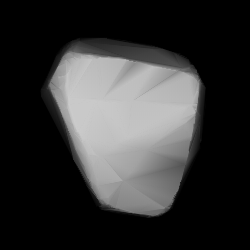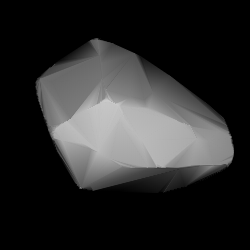
748 Simeïsa is a very large Hilda asteroid from the outermost regions of the asteroid belt, approximately 104 kilometers in diameter. It was discovered on 14 March 1913, by Russian astronomer Grigory Neujmin at the Simeiz Observatory on the Crimean peninsula. The dark P-type asteroid has a rotation period of 11.9 hours and a shape that is reminiscent of a tetrahedron. It was the first asteroid discovery made in Russia and named after the discovering observatory and its nearby Crimean town, Simeiz.
789 Lena, provisional designation 1914 UU, is a metallic asteroid from the middle region of the asteroid belt, approximately 24 kilometers in diameter. It was discovered on 24 June 1914, by Soviet–Russian astronomer Grigory Neujmin at Simeiz Observatory on the Crimean peninsula, and named after the discoverer's mother.

830 Petropolitana is a bright background asteroid from the outer regions of the asteroid belt. It was discovered on 25 August 1916, by Russian astronomer Grigory Neujmin at the Simeiz Observatory on the Crimean peninsula. The stony S-type asteroid has a long rotation period of 39.0 hours and measures approximately 41 kilometers in diameter. It was named after the Russian city of Saint Petersburg.
848 Inna is a carbonaceous Themistian asteroid from the outer regions of the asteroid belt. It was discovered on 5 September 1915, by astronomer Grigory Neujmin at the Simeiz Observatory on the Crimean peninsula. The C-type asteroid measures approximately 33 kilometers in diameter, while its rotation period remains unknown. It was named after Russian astronomer Inna Nikolaevna Leman-Balanovskaya (1881–1945).
917 Lyka is a background asteroid, approximately 32 kilometers in diameter, located in the inner region of the asteroid belt. It was discovered on 5 September 1915, by Russian astronomer Grigory Neujmin at the Simeiz Observatory on the Crimean peninsula. The X-type asteroid has a rotation period of 7.9 hours and is likely spherical in shape. It was named after Lyka, a friend of the discoverer's sister.

1075 Helina, provisional designation 1926 SC, is a stony Eos asteroid from the outer regions of the asteroid belt, approximately 34 kilometers in diameter. It was discovered on 29 September 1926, by astronomer Grigory Neujmin at the Simeiz Observatory on the Crimean peninsula. The asteroid was named after the discoverer's son, Helij Neujmin.
1099 Figneria, provisional designation 1928 RQ, is an asteroid from the background population of the outer regions of the asteroid belt, approximately 26 kilometers in diameter. Discovered by Grigory Neujmin at Simeiz Observatory in 1928, the asteroid was later named after Russian revolutionary activist Vera Figner.

1110 Jaroslawa is a bright background asteroid and rather slow rotator from the inner regions of the asteroid belt. The stony S-type asteroid has a rotation period of 97.4 hours and measures approximately 13 kilometers in diameter. It was discovered at the Simeiz Observatory on the Crimean peninsula on 10 August 1928, by astronomer Soviet Grigory Neujmin, who named it after his son, Jaroslav Grigorevich Neujmin.
1120 Cannonia, provisional designation 1928 RV, is a stony Florian asteroid from the inner regions of the asteroid belt, approximately 10 kilometers in diameter. Discovered by Pelageya Shajn at Simeiz in 1928, it was named after American astronomer Annie Jump Cannon.
1123 Shapleya, provisional designation 1928 ST, is a stony Florian asteroid from the inner regions of the asteroid belt, approximately 11 kilometers in diameter. It was discovered on 21 September 1928, by Russian astronomer Grigory Neujmin at Simeiz Observatory on the Crimean peninsula. It was named after American astronomer Harlow Shapley.

1129 Neujmina is an Eos asteroid from the outer regions of the asteroid belt. It was discovered on 8 August 1929, by astronomer Praskoviya Parchomenko at the Simeiz Observatory on the Crimean peninsula. The stony S-type asteroid has a rotation period of 5.1 hours and measures approximately 34 kilometers in diameter. It was named after Soviet astronomer Grigory Neujmin.

1137 Raïssa is a stony background asteroid and slow rotator, approximately 22 kilometers in diameter, located in the inner regions of the asteroid belt. It was discovered by Grigory Neujmin at Simeiz Observatory in 1929, and named in memory of Raïssa Maseeva, who worked at the Pulkovo Observatory.

1277 Dolores is a carbonaceous background asteroid from the central regions of the asteroid belt, approximately 27 kilometers in diameter. It was discovered on 18 April 1933, by Soviet astronomer Grigory Neujmin at the Simeiz Observatory on the Crimean peninsula. The asteroid was named after Spanish communist Dolores Ibárruri.

1379 Lomonosowa is a stony background asteroid from the central regions of the asteroid belt, approximately 19 kilometers in diameter. Discovered by Grigory Neujmin at the Simeiz Observatory in 1936, the asteroid was later named after Russian physicist and astronomer Mikhail Lomonosov.

1459 Magnya, provisional designation 1937 VA, is a basaltic, slightly elongated asteroid from the outer regions of the asteroid belt, approximately 20 kilometers in diameter. Discovered by Grigory Neujmin at the Simeiz Observatory in 1937, this background asteroid was later named from the Latin word "Magnya", which means "clear, bright, wonderful" when literally translated into Russian. It is the only known basalt asteroid orbiting beyond 4 Vesta.
1190 Pelagia, provisional designation 1930 SL, is a dark Nysian asteroid from the inner regions of the asteroid belt, approximately 17 kilometers in diameter. It was discovered on 20 September 1930, by Soviet–Georgian astronomer Grigory Neujmin at the Simeiz Observatory on the Crimean peninsula. The asteroid was named after astronomer Pelageya Shajn.

1484 Postrema, provisional designation 1938 HC, is a carbonaceous Postremian asteroid and namesake of the Postrema family from the central regions of the asteroid belt, approximately 41 kilometers in diameter. It was discovered on 29 April 1938, by Soviet astronomer Grigory Neujmin at the Simeiz Observatory on the Crimean peninsula. The name "Postrema" celebrates the astronomer's last minor planet discovery.
1255 Schilowa, provisional designation 1932 NC, is a background asteroid from the outer regions of the asteroid belt, approximately 34 kilometers in diameter. It was discovered on 8 July 1932, by Soviet astronomer Grigory Neujmin at the Simeiz Observatory on the Crimean peninsula. The asteroid has a longer-than average rotation period of 29.5 hours. It was named after Mariya Zhilova (Schilowa), who was Russia's first professional female astronomer.
1734 Zhongolovich, provisional designation 1928 TJ, is a carbonaceous Dorian asteroid from the central region of the asteroid belt, approximately 28 kilometers in diameter.

1289 Kutaïssi is a stony Koronian asteroid from the outer region of the asteroid belt. Discovered by Grigory Neujmin at Simeiz Observatory in 1933, it was later named after the Georgian city of Kutaisi. The S-type asteroid has a rotation period of 3.6 hours and measures approximately 22 kilometers in diameter.











